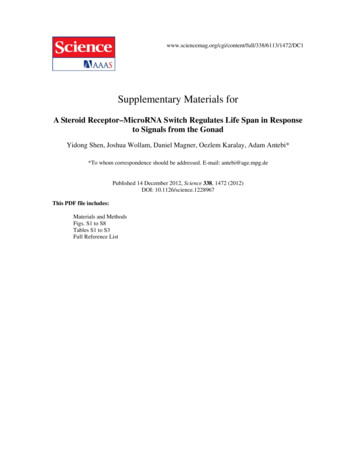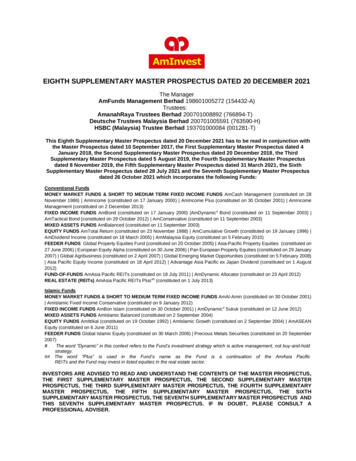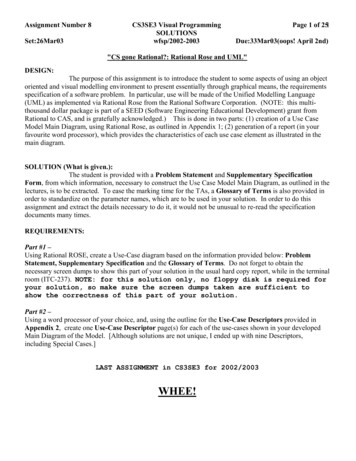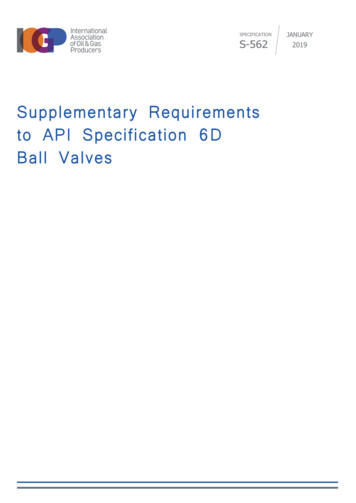
Transcription
DC1Supplementary Materials forA Steroid Receptor–MicroRNA Switch Regulates Life Span in Responseto Signals from the GonadYidong Shen, Joshua Wollam, Daniel Magner, Oezlem Karalay, Adam Antebi**To whom correspondence should be addressed. E-mail: antebi@age.mpg.dePublished 14 December 2012, Science 338, 1472 (2012)DOI: 10.1126/science.1228967This PDF file includes:Materials and MethodsFigs. S1 to S8Tables S1 to S3Full Reference List
Supplemental MaterialsMaterials and MethodsC. elegans strains and cultureNematodes were grown with standard techniques at 20ºC unless otherwise noted (23). Allstrains with glp-1(e2141) were maintained at 15ºC and grown at 25ºC to inducegermlineless phenotype. NGM plates with ethanol or Δ4-dafachronic acid were preparedas reported (4). daf-16(mu86);muIs109(Pdaf-16::daf-16::gfp; Podr-1::rfp), pha1(e2123);arEx1273(lin-14::gfp), and nhr-80(tm1011);glp-1(e2141) were kindlyprovided by Dr. Kenyon (UCSF), Dr. Greenwald (Columbia U.) and Dr. Aguilaniu (ENSde Lyon) respectively. Strains used are listed in Table S2.TransgenesPlasmids, akt-1p::DR::akt-1u, akt-1p::DR::unc-1u, pdk-1p::DR::pdk-1u, pdk1p::DR::unc-1u, lin-14p::DR::lin-15u, and lin-14p::DR::unc-1u were injected into N2 togenerate dhEx765, dhEx768, dhEx772, dhEx776, dhEx779, and dhEx781, respectively.For dhEx842, N2 was injected with mir-241p::mir-241, mir-84p::mir-84, and a cotransformation marker, myo-2::mCherry.RNA interferenceRNAi experiments were performed as described (24). For RNAi of cco-1, daf-2 and daf16, synchronized eggs were seeded on HT115 plates expressing corresponding dsRNA.For RNAi of akt-1, lin-14, and other heterochronic genes, synchronized larvae were
grown on OP50 plates until late L4 and transferred to corresponding HT115 plates forRNA interference.Lifespan assaysAblation of germline precursor cells by laser microsurgery and adult lifespan analysiswere performed as previously reported (25). Worms undergoing internal hatching,bursting vulva, or crawling off the plates were censored. Statistical analysis wasperformed with the Mantel-Cox Log Rank method.GC/MS/MS analysisWorms were synchronized by bleaching and grown until day 1 of adulthood for analysis.Lipids were extracted from worms via the Bligh and Dyer method before derivitizing forGC-MS analysis (26). 7-dehydrocholesterol and dafachronic acid (DA) levels wereanalyzed by GC/MS/MS on a 7000A Triple Quadrupole GC/MS instrument (AgilentTechnologies) equipped with an ESI source and an HP5-ms column. Whole-worm lipidextracts were spiked with cholesterol-d7 and 5β-cholanic acid as internal standards andthen derivitized with either Fluka III (Sigma) or trimethylsilyldiazomethane (Sigma) for7-dehydrocholesterol or DA analysis, respectively. Compounds were analyzed in MRMmode using the following transitions: cholesterol-d7 (m/z 465.4Æ360.3), 7dehydrocholesterol (m/z 350.2Æ195.0), 5β-cholanic acid (m/z 374.3Æ264.0) and Δ7-DA(m/z 428.3Æ229). The results were from three independent experiments.
Plasmid constructionTo generate pDR, pMyo-LD17, a gift from Dr. Lo, was modified by first removing themyo-2 promoter and L-HDAg gene within, then replacing the original unc-54 3’UTRwith unc-1 3’UTR. The Dual Reporter (DR) module in pDR consists of gfp::icr::rfp asreported (27). DR reporters were subsequently generated from pDR as follows:akt-1p::DR::akt-1u and akt-1p::DR::unc-1uThe akt-1 promoter of 3.2 kb was amplified from genomic DNA by PCR and inserted infront of the DR module. For akt-1p::DR::akt-1u, a 444 bp akt-1 3’UTR was amplifiedfrom genomic DNA and cloned after the DR module.pdk-1p::DR::pdk-1u and pdk-1p::DR::unc-1uThe pdk-1 promoter of 2.9 kb was amplified from genomic by PCR and inserted in frontof the DR module. For pdk-1p::DR::pdk-1u, pdk-1 3’UTR of 492 bp was amplified fromgenomic DNA and cloned after the DR module.lin-14p::DR::lin-14u and lin-14p::DR::unc-1uThe lin-14 promoter (5.2 kb) was amplified from genomic DNA by PCR and clonedbefore the DR module. For lin-14p::DR::lin-14u, a 1.5 kb lin-14 3’UTR was amplifiedfrom genomic DNA and cloned after the DR module.To generate mir-241p::mir-241 and mir-84p::mir84, a 2.0 kb mir-241 promoter, a 2.8 kbmir-84 promoter, and the microRNA stem-loops together with 200 bp of flankingsequence were PCR amplified from genomic DNA. PCR fragments were subsequentlycloned into L3781 (Fire vector kit 1997).
For luciferase assays, 3’UTRs of interest were amplified from genomic DNA by PCR andcloned after the luciferase gene in pMIR-REPORT Luciferase (Ambion). For plasmidsexpressing mature microRNAs, the stem-loop of tested microRNA and 200 bp offlanking sequence were amplified from genomic DNA by PCR and cloned into the3’UTR of GFP in pEGFP-C1.Cell culture and transfectionHEK293T cells were maintained in DMEM medium supplemented with 10% fetal bovineserum (Gibco). Transfections were performed with FuGENE HD (Roche) according tothe manufacturer’s instruction.Luciferase assayPlasmids expressing microRNAs were co-transfected into HEK293T cells with fireflyand renilla luciferase reporters. Luciferase activities were measured with Dual-LuciferaseReporter Assay System (Promega) 24 h post transfection. The 3’UTR of interest wasfused with firefly luciferase and renilla luciferase serves as an internal control. At leastthree independent experiments were performed.qRT-PCRSynchronized worms were grown until day 1 of adulthood unless otherwise noted.Afterwards, worms were collected in TRIzol (Invitrogen) and frozen in liquid nitrogen.For mRNA, total RNA was prepared by RNeasy Mini kit (QIAGEN) and cDNA wassubsequently generated by Superscript III First Strand Synthesis System with randomhexamers (Invitrogen). For microRNA, miRNeasy Mini kit (QIAGEN) and TaqManMicroRNA Reverse Transcription kit (Applied Biosystems) were used for total RNA and
cDNA preparation respectively. qRT-PCR was performed with Power SYBR Greenmaster mix (Applied Biosystems) on a 7900HT Fast Real-Time PCR System (AppliedBiosystems). Three or four technical replicates were performed in each reaction. ama-1and Sno-RNA U18 were used as internal controls for mRNA and microRNA qRT-PCRrespectively. The results were from at least three biological replicates. Primer sequencesare listed in Table S3.Analysis of fluorescence intensityFluorescence intensity was measured by COPAS Biosort (Union Biometrica), or frommicroscopic pictures by Photoshop (Adobe) or ImageJ (http://rsbweb.nih.gov/ij/) asindicated. For microscopic pictures, background signal was substracted as reported (28).Fluorescence microscopy was performed on a Carl Zeiss Axio Imager Z1. For analysis ofmir-84p::GFP and mir-241p::GFP, images of indicated tissues were calibrated withInSpeck Green Microscopy Image Intensity Calibration Beads (Molecular Probes).Statistical analysisResults are presented as mean SD unless noted otherwise. Statistical tests wereperformed with either One-way ANOVA with Tukey test (ANOVA) or Student’s t-test(t-test) as indicated using GraphPad Prism (GraphPad software).
Supplementary Figures and TablesFig. S1. Loss of the germline alters the expression of hormone synthetic genes.A. qRT-PCR results of the indicated genes in WT and glp-1 worms in Day 1 adults. ttest, * P 0.05, *** P 0.001, ns: non-significant.B and C. The upregulation of daf-36 expression in germlineless animals is not regulatedby DAF-16/FOXO (B) or DAF-12 (C) in Day 1 adults. ANOVA: * P 0.05, ns: nonsignificant.D. At day 1 adulthood, daf-36::gfp expression is elevated in the absence of germline.3403 dhEx320 and 3141 glp-1;dhEx320 worms were analyzed by COPAS Biosort infive independent experiments. t-test, *** P 0.001.
Fig. S2. Analysis of microRNA expression patterns in germlineless animals.A. qRT-PCR results showing mir-48, mir-228, and let-7 levels at indicated time points.L3, L4: 3rd and 4th larval stage. D1: day 1 adult, D4: day 4 adult, and D10: day 10adult. Error bars: SEM.B-D. let-7 (B), mir-48 (C) and mir-228 (D) are not regulated by DA/DAF-12 signaling.Worms with indicated genotypes were grown on plates with ethanol (EtOH) or Δ4-
dafachronic acid (DA) until young adulthood without bearing eggs. ANOVA: vs glp1 EtOH, * P 0.05, ** P 0.01, ns: non-significant.E. Quantification of mir-84p::GFP and mir-241p::GFP intensity in WT and glp-1 wormsat day 1 of adulthood. For mir-84p::GFP, 31 WT and 33 glp-1 worms were examined.For mir-241p::GFP, 44 WT and 49 glp-1 worms were examined. The results werefrom three independent experiments. t-test: * P 0.05, ** P 0.01.F. The upregulation of mir-48, mir-84, and mir-241 in germlineless animals isindependent of nhr-80. Error bars: SEM. ANOVA, ns: non-significant.Fig. S3. mir-84 and mir-241 specifically regulate gonadal longevity.A. Gonadal longevity is significantly reduced in mir-84;mir-241;glp-1 worms.
B. The transgene dhEx842 (mir-84 mir-241) restores gonadal longevity in mir-84;mir241;glp-1 worms.C. Overexpressing mir-84 and mir-241 rescues the oxidative stress resistance of mir84;mir-241;glp-1 worms. ANOVA: ** P 0.01, *** P 0.001, ns: non-significantFig. S4. mir-84 and mir-241 regulate DAF-16/FOXO activity in gonadal longevity.A and B. Nuclear localization of DAF-16::GFP is impaired in mir-84;mir-241;glp-1compared to glp-1 animals.C. Overall DAF-16::GFP level in intestinal cells is not affected by mutating mir-84 andmir-241. DAF-16::GFP intensity was measured from 80 anterior intestinal cells inthree independent experiments. t-test: *** P 0.001, ns: non-significant.
Fig. S5. mir-84 and mir-241 regulate DAF-16/FOXO transcriptional activity in gonadallongevity.A. qRT-PCR results showing the indicated genes regulated by both daf-12 and daf-16upon germline removal.
B. Mutation of mir-84 and mir-241 reduces expression of the indicated genes ingermlineless animals.C. Mutation of mir-84 and mir-241 reduces sod-3::gfp expression in germlinelessanimals.D. daf-16RNAi does not further decrease the expression of indicated genes in mir84;mir-241;glp-1 compared to glp-1 animals.Bars: SEM. ANOVA: * P 0.05, ** P 0.01, *** P 0.001, ns: non-significant.Fig. S6. The effect of mir-84 and mir-241 on the transcriptional output of other majorregulators in gonadal longevity.A. fard-1 is regulated by daf-12 but not daf-16 upon germline removal.
B and C. Upon germline ablation, mutation of mir-84 and mir-241 does not affect theexpression of fard-1 (B) but mildly reduces the level of cdr-6 (C).D and E. mir-84 and mir-241 do not influence the expression of lgg-1 (D), unc-51 (E), orfat-6 (F). Bars: SEM.ANOVA: * P 0.05, ** P 0.01, ns: non-significant.
Fig. S7. akt-1 and lin-14 are targets of mir-84 and mir-241.A and B. mir-84 and mir-241 target the 3’UTRs of akt-1 and lin-14. HEK293T cellswere transfected as indicated to co-express luciferase reporter with the 3’UTR of
interest and corresponding microRNAs. ANOVA: vs Vector, *** P 0.001, ns: nonsignificant.C. A diagram showing the working mechanism of the DR reporter. A DR reporter, basedon the operon CEOP5428, expresses two fluorescent proteins simultaneously.Whereas the expression of GFP is controlled only by the promoter, RFP is under theregulation of both the promoter and the fused 3’UTR. When the 3’UTR of interest istargeted by microRNA, the GFP expression remains unchanged while the RFP levelwill be reduced. Therefore, a decreased RFP/GFP ratio indicates the interactionbetween the microRNA and the 3’UTR.D and E. Upon germline ablation, lin-14::gfp is downregulated in intestinal nuclei of lateL4 worms. 61 intestinal nuclei from 21 mock ablated worms, and 91 intestinal nucleifrom 27 ablated worms were scored. Arrow heads: intestinal nucleus. t-test: ***P 0.001.F. sod-3 expression is restored in mir-84;mir-241;glp-1 animals upon akt-1 or lin-14RNAi treatment. ANOVA: ** P 0.01, ns: non-significant.G and H. pdk-1-3’UTR-DR construct is upregulated in mir-84;mir-241 mutantscompared to WT.I. glp-1 mutants do not show downregulation of the pdk-1-3’UTR-DR construct.
Fig. S8. ModelSignaling underlying gonadal longevity with an intact germline (left) or upon germlineablation (right). See Discussion for details. Black lines: activated signaling, grey lines:inhibited signaling, solid lines: direct interactions, dashed lines: indirect interactions.
Table S1. Lifespan analysis of microRNA-deficient and germlineless animals.WT MockMedianLifespan SD(days)22.3 2.9WT Ablated40.7 6.0174/225vs WT Mock, P 0.0001Fig. 2Amir-84;mir-241 Mock22.3 4.7191/266vs WT Mock, nsFig. 2Amir-84;mir-241 Ablated18.7 2.5173/204WT21.7 1.2341/450glp-132.7 6.4364/407vs WT, P 0.0001Fig. S3Amir-84;mir-24123.0 2.0306/450vs WT, nsFig. S3Amir-84;mir-241;glp-122.3 4.2343/406mir-24123.0 4.0*177/300vs WT, nsFig. S3Amir-241;glp-124.5 3.0*232/300vs glp-1, nsFig. S3Amir-4812**98/150vs WT, P 0.0001Fig. S3Amir-48;glp-121**107/120vs glp-1, P 0.0001Fig. S3Amir-8423.0 8.0*213/300vs WT, nsFig. S3Amir-84;glp-126.0 6.0*240/300vs glp-1, nsFig. S3AWT24.0 1.0231/320dhEx84226.7 1.5208/320vs WT, nsFig. S3Bglp-131.0 2.6287/320vs WT, P 0.0001Fig. S3Bglp-1;dhEx84234.0 2.0*202/240vs glp-1, nsFig. S3Bmir-84;mir-241;glp-124.0 1.0275/320vs glp-1, P 0.0001Fig. S3BStrain/Treatment# WormsP value193/278FigureFig. 2Avs WT Mock, nsvs WT Ablated, P 0.0001Fig. 2AFig. S3Avs WT, nsvs glp-1, P 0.0001Fig. S3AFig. S3Bvs glp-1, nsmir-84;mir-241;glp-1;dhEx84232.0 1.0208/304vs mir-84;mir-241;glp-1,Fig. S3BP 0.0001WT; L444021.3 0.6223/360Fig. 2Bmir-84;mir-241; L444023.7 1.2239/360vs WT; L4440, nsFig. 2BWT; daf-2 RNAi43.0 10.5201/360vs WT; L4440, P 0.0001Fig. 2Bmir-84;mir-241; daf-2 RNAi45.3 7.1177/360vs WT; daf-2 RNAi, nsFig. 2BWT; cco-1 RNAi29.7 0.6184/360vs WT; L4440, P 0.0001Fig. 2Bmir-84;mir-241; cco-1 RNAi33.0 1.0152/360vs WT; cco-1 RNAi, nsFig. 2BWT; L444022.5 0.5*178/260WT; daf-16 RNAi19.5 0.5*210/260vs WT; L4440, P 0.0001Fig. 2Cmir-84;mir-241; L444024.0 2.0*185/260vs WT; L4440, nsFig. 2CFig. 2C
mir-84;mir-241; daf-16 RNAi20.5 0.5*213/260vs WT; daf-16 RNAi, nsFig. 2Cglp-1; L444031 4.0*221/260vs WT; L4440, P 0.0001Fig. 2Cglp-1; daf-16 RNAi20.5 0.5*219/260vs WT; daf-16 RNAi, nsFig. 2Cvs glp-1; L4440, P 0.0001mir-84;mir-241;glp-1; L444025.5 0.5*221/260vs WT; daf-16 RNAi, nsFig. 2Cvs glp-1; daf-16 RNAi, nsmir-84;mir-241;glp-1;20.5 0.5*234/260WT; L444021.0 1.0223/360WT; akt-1 RNAi26.7 1.5240/360vs WT; L4440, P 0.0001Fig. 3Emir-84;mir-241; L444023.7 1.2246/360vs WT; L4440, nsFig. 3Emir-84;mir-241; akt-1 RNAi28.7 1.5214/360vs mir-84;mir-241; L4440,Fig. 3Eglp-1; L444028.0 1.0214/360vs WT; L4440, P 0.0001Fig. 3Eglp-1; akt-1 RNAi34.5 6.0*122/181vs glp-1; L4440, P 0.01Fig. 3Emir-84;mir-241;glp-1; L444023.0 2.0273/360vs glp-1; L4440, P 0.0001Fig. 3Evs mir-84;mir-241;glp-1;Fig. 3Edaf-16 RNAimir-84;mir-241;glp-1;akt-1 RNAi35.7 2.9301/360vs WT; daf-16 RNAi, nsFig. 2CFig. 3EP 0.0001L4440, P 0.0001vs glp-1; akt-1 RNAi, nsWT; L444022.3 2.1201/345WT; lin-14 RNAi28.0 1.5188/345vs WT; L4440, P 0.0001Fig. 4Amir-84;mir-241; L444024.0 2.0*191/240vs WT; L4440, nsFig. 4Amir-84;mir-241; lin-14 RNAi28.5 3.0*150/240vs mir-84;mir-241; L4440,Fig. 4Aglp-1; L444031.3 2.1286/344vs WT; L4440, P 0.0001Fig. 4Aglp-1; lin-14 RNAi32.3 0.6285/346vs glp-1; L4440, nsFig. 4Amir-84;mir-241;glp-1; L444026.7 0.6299/347vs glp-1; L4440, P 0.0001Fig. 4Avs mir-84;mir-241;glp-1;Fig. 4A35.3 4.9266/345mir-84;mir-241;glp-1;lin-14 RNAiFig. 4AP 0.0001L4440, P 0.0001vs glp-1; lin-14 RNAi, nsWT; lin-28 RNAi21.0 7.8225/374vs WT; L4440, nsmir-84;mir-241; lin-28 RNAi22.3 5.5197/365vs mir-84;mir-241; L4440, nsglp-1; lin-28 RNAi26.0 1.7266/365vs glp-1; L4440, P 0.000122.0 5.6249/365WT; lin-41 RNAi18.0**75/120mir-84;mir-241; lin-41 RNAi18.0**84/120mir-84;mir-241;glp-1; lin-28RNAivs mir-84;mir-241;glp-1;L4440, nsvs WT; L4440, P 0.0001vs mir-84;mir-241; L4440,P 0.0001
glp-1; lin-41 RNAi25.0**98/12025.0**84/120WT; hbl-1 RNAi21.7 6.7248/365vs WT; L4440, nsmir-84;mir-241; hbl-1 RNAi21.0 7.8288/364vs mir-84;mir-241; L4440, nsglp-1; hbl-1 RNAi29.7 5.0291/365vs glp-1; L4440, ns26.7 2.1258/365mir-84;mir-241;glp-1; lin-41RNAimir-84;mir-241;glp-1; hbl-1RNAivs glp-1; L4440, P 0.0001vs mir-84;mir-241;glp-1;L4440, nsvs mir-84;mir-241;glp-1;L4440, nsAt least three independent experiments were performed for aging analysis unlessotherwise noted. P values were calculated by the Mantel-Cox Log Rank test forcomparing aging curves. ns: non-significant. # worms: the number of observed deadworms/the number of worms at the start of the experiment. The worms undergoinginternal hatching, bursting vulva, or crawling off the plates were censored.* Two independent experiments were performed. Data shown as Mean with Range.** This experiment was performed only once.Table S2. Gene alleles and strains.N2 rh411);glp-1(e2141)
5);glp-1(e2141)N2;dhEx842(mir-84 mir-241 -1(e2141); 241(n4315);dhEx779glp-1(e2141);dhEx779
N2;dhEx781 14::gfp)Table S3. qRT-PCR primersGenePrimerSequence TTCACAC
CGATCA
References and Notes1. H. Hsin, C. Kenyon, Signals from the reproductive system regulate the lifespan of C.elegans. Nature 399, 362 (1999). doi:10.1038/20694 Medline2. N. Arantes-Oliveira, J. Apfeld, A. Dillin, C. Kenyon, Regulation of life-span by germline stem cells in Caenorhabditis elegans. Science 295, 502 (2002).doi:10.1126/science.1065768 Medline3. T. Flatt et al., Drosophila germ-line modulation of insulin signaling and lifespan. Proc.Natl. Acad. Sci. U.S.A. 105, 6368 (2008). doi:10.1073/pnas.0709128105 Medline4. B. Gerisch et al., A bile acid-like steroid modulates Caenorhabditis elegans lifespanthrough nuclear receptor signaling. Proc. Natl. Acad. Sci. U.S.A. 104, 5014(2007). doi:10.1073/pnas.0700847104 Medline5. T. M. Yamawaki et al., The somatic reproductive tissues of C. elegans promotelongevity through steroid hormone signaling. PLoS Biol. 8, e1000468 (2010).doi:10.1371/journal.pbio.1000468 Medline6. J. R. Berman, C. Kenyon, Germ-cell loss extends C. elegans life span throughregulation of DAF-16 by kri-1 and lipophilic-hormone signaling. Cell 124, 1055(2006). doi:10.1016/j.cell.2006.01.039 Medline7. M. McCormick, K. Chen, P. Ramaswamy, C. Kenyon, New genes that extendCaeonorhabditis elegans’ lifespan in response to reproductive signals. Aging Cell11, 192 (2012). Medline8. J. Wollam et al., A novel 3-hydroxysteroid dehydrogenase that regulates reproductivedevelopment and longevity. PLoS Biol. 10, e1001305 (2012).doi:10.1371/journal.pbio.1001305 Medline9. J. Wollam et al., The Rieske oxygenase DAF-36 functions as a cholesterol 7desaturase in steroidogenic pathways governing longevity. Aging Cell 10, 879(2011). doi:10.1111/j.1474-9726.2011.00733.x Medline10. T. Yoshiyama-Yanagawa et al., The conserved Rieske oxygenase DAF-36/Neverlandis a novel cholesterol-metabolizing enzyme. J. Biol. Chem. 286, 25756 (2011).doi:10.1074/jbc.M111.244384 Medline11. A. Bethke, N. Fielenbach, Z. Wang, D. J. Mangelsdorf, A. Antebi, Nuclear hormonereceptor regulation of microRNAs controls developmental progression. Science324, 95 (2009). doi:10.1126/science.1164899 Medline12. C. M. Hammell, X. Karp, V. Ambros, A feedback circuit involving let-7-familymiRNAs and DAF-12 integrates environmental signals and developmental timingin Caenorhabditis elegans. Proc. Natl. Acad. Sci. U.S.A. 106, 18668 (2009).doi:10.1073/pnas.0908131106 Medline13. J. Goudeau et al., Fatty acid desaturation links germ cell loss to longevity throughNHR-80/HNF4 in C. elegans. PLoS Biol. 9, e1000599 (2011).doi:10.1371/journal.pbio.1000599 Medline
14. M. C. Wang, E. J. O’Rourke, G. Ruvkun, Fat metabolism links germline stem cellsand longevity in C. elegans. Science 322, 957 (2008).doi:10.1126/science.1162011 Medline15. L. R. Lapierre, S. Gelino, A. Meléndez, M. Hansen, Autophagy and lipid metabolismcoordinately modulate life span in germline-less C. elegans. Curr. Biol. 21, 1507(2011). doi:10.1016/j.cub.2011.07.042 Medline16. M. Hammell et al., mirWIP: microRNA target prediction based on microRNAcontaining ribonucleoprotein-enriched transcripts. Nat. Methods 5, 813 (2008).doi:10.1038/nmeth.1247 Medline17. C. J. Kenyon, The genetics of ageing. Nature 464, 504 (2010).doi:10.1038/nature08980 Medline18. S. Paradis, G. Ruvkun, Caenorhabditis elegans Akt/PKB transduces insulin receptorlike signals from AGE-1 PI3 kinase to the DAF-16 transcription factor. GenesDev. 12, 2488 (1998). doi:10.1101/gad.12.16.2488 Medline19. T. D. Resnick, K. A. McCulloch, A. E. Rougvie, miRNAs give worms the time oftheir lives: Small RNAs and temporal control in Caenorhabditis elegans. Dev.Dyn. 239, 1477 (2010). Medline20. M. Boehm, F. Slack, A developmental timing microRNA and its target regulate lifespan in C. elegans. Science 310, 1954 (2005). doi:10.1126/science.1115596Medline21. K. Boulias, H. R. Horvitz, The C. elegans microRNA mir-71 acts in neurons topromote germline-mediated longevity through regulation of DAF-16/FOXO. CellMetab. 15, 439 (2012).22. H. Zhu et al., The Lin28/let-7 axis regulates glucose metabolism. Cell 147, 81 (2011).doi:10.1016/j.cell.2011.08.033 Medline23. S. Brenner, The genetics of Caenorhabditis elegans. Genetics 77, 71 (1974). Medline24. R. S. Kamath, M. Martinez-Campos, P. Zipperlen, A. G. Fraser, J. Ahringer,Effectiveness of specific RNA-mediated interference through ingested doublestranded RNA in Caenorhabditis elegans. Genome Biol. 2, H0002 (2001).Medline25. B. Gerisch, C. Weitzel, C. Kober-Eisermann, V. Rottiers, A. Antebi, A hormonalsignaling pathway influencing C. elegans metabolism, reproductive development,and life span. Dev. Cell 1, 841 (2001). doi:10.1016/S1534-5807(01)00085-5Medline26. E. G. Bligh, W. J. Dyer, A rapid method of total lipid extraction and purification.Can. J. Biochem. Physiol. 37, 911 (1959). doi:10.1139/o59-099 Medline27. L. W. Lee, H. W. Lo, S. J. Lo, Vectors for co-expression of two genes inCaenorhabditis elegans. Gene 455, 16 (2010). doi:10.1016/j.gene.2010.02.001Medline
28. J. M. King, T. S. Hays, R. B. Nicklas, Dynein is a transient kinetochore componentwhose binding is regulated by microtubule attachment, not tension. J. Cell Biol.151, 739 (2000). doi:10.1083/jcb.151.4.739 Medline
cDNA preparation respectively. qRT-PCR was performed with Power SYBR Green master mix (Applied Biosystems) on a 7900HT Fast Real-Time PCR System (Applied Biosystems). Three or four technical replicates were performed in each reaction. ama-1 and Sno-RNA U18 were used as internal controls for mRNA and microRNA qRT-PCR respectively.











